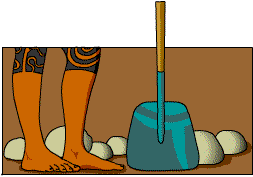Hangi - A New Zealand Feast Of Food
Created | Updated Jan 28, 2002

In pre-European times the native New Zealand Maori people cooked their meals in earthen pits. These pits contained heated stones that steamed the food which had been placed in baskets made from flax. While this method is still occasionally followed today by all manner of New Zealanders, a hangi (pronounced 'hungee'), as the method is called, is more likely nowadays to be done utilising modern materials. The method is a good way to feed and simultaneously amuse a large number of people for several hours, and is a particularly enjoyable method for barbecuing for that reason.
The Traditional Hangi
A pit is dug and rocks are placed in the bottom. Quite a large pile of wood is then stacked, and once lit, burns down to embers. Enough wood is used to ensure the fire lasts about an hour.
While the fire is burning down, prepare the baskets to be placed in the pit. Each basket contains a separate food item and all items are wrapped with edible leaves. Cabbage and watercress are both recommended for this.
Once the fire has burned down the stones should be red-hot. Remove any debris - you want to steam your food, not smoke it.
Now place the baskets in the pit. Some of the stones should be placed at the bottom of the pit, others on top of the baskets. This placement of the red-hot stones ensures your food is evenly cooked.1 Once this is completed, the baskets and rocks are covered with wet burlap sacks and water is sprayed over it all to ensure enough steam is present to cook the food.
The final stage is where dirt is shovelled on top of the pit in order for the steam to cook everything. Once enough time has elapsed, usually between two and three hours, the whole process is reversed and you end up with the cooked food ready to be served.
The Modern Version
Dig two holes approximately two metres long, one metre wide and one metre deep. The dimensions depend on how many food baskets you are preparing. Into the first hole place about a dozen railway irons2 cut into 30 centimetre lengths. On top of these build a bonfire and light it.
While the fire heats the irons the food is prepared - this is men's work3 though ladies may peel the kumeras4 and pumpkin. These are placed into baskets made out of fencing wire which are similar to milk-crates. There are usually three or four of these, depending on how many people you are feeding.
Use white meat (pork, chicken etc) and fish. Avoid red meat as it dries out too quickly. Vegetables to use are potatoes, kumera, pumpkin, cabbage, watercress or similar. The food is wrapped in tinfoil and placed in the wire baskets which have been lined with damp linen sheets.
Now the hot work starts. Organise the silliest men to drag the white-hot irons out of the fire hole and place them in the adjoining empty hole. This is best done with rakes as the irons have holes you can hook on to. This must be done quickly - you don't want to lose the heat from the irons. The food baskets are then placed evenly on top of the irons. Make sure the linen is still damp. On top of the baskets you position six large, thick, dripping wet sacks. The dirt originally dug from the holes is now shovelled on top and patted down to ensure no steam leaks out. Always keep an eye out for escaping steam - it means your oven is leaking and the food is not being evenly cooked.
Waiting For The Food To Cook
After four hours, best spent sitting on garden furniture drinking cold beer and chatting to your mates while the women do their thing with the children; your meal is cooked.
Remove the dirt - the smell at this point is mouth-watering - then the sacks and the baskets. Take the baskets of food to the tent you have previously erected.
Serving And Eating
Inside this tent will be a trestle table covered in white newsprint. At the top end of the table one of the men will carve the meat and all your guests will walk around the table with paper plates selecting whatever food they want to eat. At some really organised hangis, women bring plates of salad to add to the feast.
Don't forget to place the pudding in the hangi or you will end up with boiled, instead of steamed, pudding for dessert.
The Aftermath
If you get really lucky some of your mates will turn up next day to help you clean up the mess. Some comments you are likely to hear the following day include:-
The grass will grow back.
The neighbours weren't talking anyway.
Nice day for a beer.

